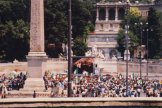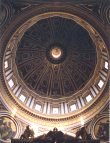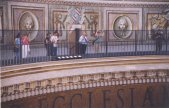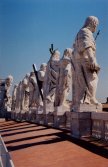Exploring Rome - June 17-20, 2002
June 18, 2002 - Catacombs and Appian Way
 On Monday, Italy was playing in the World Cup -- what turned out to be Italy's final game --
and as usual much of the city shut down to watch. I headed over to the Piazza del Populo,
where they had set up large screens and watched some of the mayhem as the fans reacted to
their team's travails.
On Monday, Italy was playing in the World Cup -- what turned out to be Italy's final game --
and as usual much of the city shut down to watch. I headed over to the Piazza del Populo,
where they had set up large screens and watched some of the mayhem as the fans reacted to
their team's travails.
 On Tuesday, I headed out the Appian Way to see some of the catacombs, south of the city.
Getting there proved to be a bit of a hassle. You have to take the underground (Line 1 -
Red) to San Giovanni, go through the wall, into the city, and head slightly to the left to
pick up the 218 bus in the Piazza di San Giovanni. As the bus headed onto the old Appian
Way, I saw the only remaining milestone (see right). The Calisto
catacombs are the first the bus comes to once on the Appian Way. They have tours
every 10-20 minutes, in a variety of languages, although most are in Italian and English.
On Tuesday, I headed out the Appian Way to see some of the catacombs, south of the city.
Getting there proved to be a bit of a hassle. You have to take the underground (Line 1 -
Red) to San Giovanni, go through the wall, into the city, and head slightly to the left to
pick up the 218 bus in the Piazza di San Giovanni. As the bus headed onto the old Appian
Way, I saw the only remaining milestone (see right). The Calisto
catacombs are the first the bus comes to once on the Appian Way. They have tours
every 10-20 minutes, in a variety of languages, although most are in Italian and English.
 The Christians buried their dead, while the Romans cremated their dead. Christians were
not allowed to be buried within the city walls, so they dug the catacombs outside the city,
which were also used occasionally to hide people and to conduct services. Approximately
500,000 people are buried in four levels of catacombs, only one of which is open to the
public, and you are not allowed into the areas where there are still people interred.
The Christians buried their dead, while the Romans cremated their dead. Christians were
not allowed to be buried within the city walls, so they dug the catacombs outside the city,
which were also used occasionally to hide people and to conduct services. Approximately
500,000 people are buried in four levels of catacombs, only one of which is open to the
public, and you are not allowed into the areas where there are still people interred.
 There are a lot of christian symbols marking the graves (see left), and the tunnels go
off at odd angles, which can lead to disorientation. On the plus side, it was nice and
cool in the tunnels! There are also some chapels and statues. The graves tend to be in
small rooms off the main corridors and often include entire families. Because none are
marked, there used to be guides who would direct you to where your loved ones were buried.
There are a lot of christian symbols marking the graves (see left), and the tunnels go
off at odd angles, which can lead to disorientation. On the plus side, it was nice and
cool in the tunnels! There are also some chapels and statues. The graves tend to be in
small rooms off the main corridors and often include entire families. Because none are
marked, there used to be guides who would direct you to where your loved ones were buried.
 Although photography is not allowed (which is why I didn't bring my camera in) I saw a nun
taking pictures, with a flash. So I was determined to come back and take a few pictures of
my own. I did just that a couple of weeks later when I brought some others from school.
There are several popes buried in the catacombs (7 I think), including Lucius (see above
right). Another piece of trivia, the average lifespan for the poor in Roman times was
18-20 years. The average lifespan for the rich was 60-65. I would have to say that
it is probably better to be rich!
Although photography is not allowed (which is why I didn't bring my camera in) I saw a nun
taking pictures, with a flash. So I was determined to come back and take a few pictures of
my own. I did just that a couple of weeks later when I brought some others from school.
There are several popes buried in the catacombs (7 I think), including Lucius (see above
right). Another piece of trivia, the average lifespan for the poor in Roman times was
18-20 years. The average lifespan for the rich was 60-65. I would have to say that
it is probably better to be rich!
In addition to the catacombs at Callisto, there are several other catacombs as well. A
couple can be reached by the same bus (218). The different catacombs are open on different
days and between different hours. After leaving the catacombs I walked back down the
Appian Way, to the old city walls (see left) and caught the bus back to the underground.
The piece of the Appian Way near the Callisto catacombs has no real shoulder and walls to
either side. This makes it rather dangerous to walk along.
June 19, 2002 - St. Peter's Cupola
 I headed back to St. Peter's to climb up the cupola. It offers great views of the city,
as it is one of the tallest buildings in the city. I headed in the main entrance and
over to the right of St. Peter's. I teld the Swiss Guards I was going to the cupola and
got my ticket. You have your choice of walking up or taking the elevator most of the way.
Of course, I walked . . . all 585 steps . . . in pants 'cause it is a church . . . in 90º
heat . . . while carrying 20 pounds of camera equipment. Possibly not the best idea. The
steps are a combination of metal steps, stone steps, spiral staircases, and even spiral
steps between the inner and outer dome (see below right).
I headed back to St. Peter's to climb up the cupola. It offers great views of the city,
as it is one of the tallest buildings in the city. I headed in the main entrance and
over to the right of St. Peter's. I teld the Swiss Guards I was going to the cupola and
got my ticket. You have your choice of walking up or taking the elevator most of the way.
Of course, I walked . . . all 585 steps . . . in pants 'cause it is a church . . . in 90º
heat . . . while carrying 20 pounds of camera equipment. Possibly not the best idea. The
steps are a combination of metal steps, stone steps, spiral staircases, and even spiral
steps between the inner and outer dome (see below right).
 The dome is huge -- one of the largest in the world -- and it is deceptive viewing it from
the floor of St. Peter's. Look at the bottom of the picture, above right. You can see the
black letters on gold. Then look at the picture to the left, the same letters are now
about six feet tall.
The dome is huge -- one of the largest in the world -- and it is deceptive viewing it from
the floor of St. Peter's. Look at the bottom of the picture, above right. You can see the
black letters on gold. Then look at the picture to the left, the same letters are now
about six feet tall.
 All of the work inside the dome is actually made up of mosaics, although from afar it looks
like paintings. You can see that the pictures on the wall in the picture to the left
are actually made up of lots of little tiles (see here).
You can walk around the whole cupola and then out onto the outside of the dome to view the
city. From the cupola you can see into the Vatican's private gardens, which include lawns,
gardens, topiary, and statues. You can also see down the long avenue, which Victor Emmanuel
built between the Vatican and Capoline Hill.
All of the work inside the dome is actually made up of mosaics, although from afar it looks
like paintings. You can see that the pictures on the wall in the picture to the left
are actually made up of lots of little tiles (see here).
You can walk around the whole cupola and then out onto the outside of the dome to view the
city. From the cupola you can see into the Vatican's private gardens, which include lawns,
gardens, topiary, and statues. You can also see down the long avenue, which Victor Emmanuel
built between the Vatican and Capoline Hill.
 There was a bit of a breeze outside, which was nice after the hot climb. However, this did
not prevent me from dripping with sweat. I could see the Residence I was living in, as well
as the Colosseum, and Capoline Hill. It was cool to see the twisting, windy streets around
the Vatican from above. After walking around the outside of the cupola, I walked down and
out on top of St. Peter's. You can walk around on the roof and even up behind the statutes
that line the front of the church (see left).
There was a bit of a breeze outside, which was nice after the hot climb. However, this did
not prevent me from dripping with sweat. I could see the Residence I was living in, as well
as the Colosseum, and Capoline Hill. It was cool to see the twisting, windy streets around
the Vatican from above. After walking around the outside of the cupola, I walked down and
out on top of St. Peter's. You can walk around on the roof and even up behind the statutes
that line the front of the church (see left).
After walking around on the roof, I walked back down the 500 or so steps from the roof.
Even if you ride up the elevator, they make you walk back down the stairs. Of course, it
is much easier walking down then it was walking up. I headed back to the Residence and
took a shower in hopes of cooling down.
June 20, 2002 - Colosseum
 A bunch of us from school headed over to the Colosseum. They do tours in a variety of
languages. The tour went around and showed off the pits, bleachers, and a portion of the
wooden floor, which has been replaced. Originally, there were sails all along the top
of the Colosseum, which were used to shade the crowd. Or at least that portion of the
crowd that paid extra to be in the shade. The sails were managed by sailors, who kept
them properly aligned.
A bunch of us from school headed over to the Colosseum. They do tours in a variety of
languages. The tour went around and showed off the pits, bleachers, and a portion of the
wooden floor, which has been replaced. Originally, there were sails all along the top
of the Colosseum, which were used to shade the crowd. Or at least that portion of the
crowd that paid extra to be in the shade. The sails were managed by sailors, who kept
them properly aligned.
 The Colessium is much like a modern stadium. The stairs are inside, with ramps leading
out to the seats. Apparently, it was designed so that the entire place could be evacuated
in about ten minutes. There used to be lifts for transporting the animals up to the floor
of the arena. Sometimes the entire floor would be flooded for sea battles.
The Colessium is much like a modern stadium. The stairs are inside, with ramps leading
out to the seats. Apparently, it was designed so that the entire place could be evacuated
in about ten minutes. There used to be lifts for transporting the animals up to the floor
of the arena. Sometimes the entire floor would be flooded for sea battles.
Although much of the place has been torn up, you can still imagine what it must have been
like when tens of thousands of people packed the place to watch some spectacle. Outside
the Colosseum, you can get your picture taken with a "roman centurion." Of course, this
costs a small fee. We skipped this honor.
| Home | Rome Journal Home |
© 2004 John Eisinger. All rights reserved
Please report any problems to me.
 On Monday, Italy was playing in the World Cup -- what turned out to be Italy's final game --
and as usual much of the city shut down to watch. I headed over to the Piazza del Populo,
where they had set up large screens and watched some of the mayhem as the fans reacted to
their team's travails.
On Monday, Italy was playing in the World Cup -- what turned out to be Italy's final game --
and as usual much of the city shut down to watch. I headed over to the Piazza del Populo,
where they had set up large screens and watched some of the mayhem as the fans reacted to
their team's travails.








